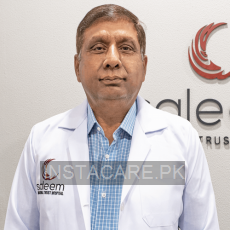Actinic Keratosis - Symptoms, Risk factors and Treatment
Last Updated On Wednesday, November 26, 2025
Actinic Keratosis in Urdu
ایکٹینک کیراٹوسس، جسے سولر کیراٹوسس بھی کہا جاتا ہے، ایک ایسی حالت ہے جس میں الٹرا وائلٹ شعاعوں کے طویل مدتی نمائش سے آپ کی جلد سرخ اور کھردری ہو جاتی ہے۔ یہ جسم کے کسی بھی حصے میں ہوسکتا ہے۔ لیکن عام طور پر یہ ہونٹوں، چہرے، کانوں، بازو، کھوپڑی، گردن اور کمر پر ہوتا ہے۔ ایکٹینک کیراٹوسس عام طور پر 40 سال کی عمر میں ظاہر ہوتا ہے۔ اس سے بچنے کے لیے، آپ کو سورج اور الٹرا وائلٹ شعاعوں سے اپنی نمائش کو کم کرنا چاہیے۔ اگر علاج نہ کیا جائے تو ایکٹینک کیراٹوسس جلد کے کینسر میں بدل سکتا ہے جسے اسکواومس سیل کارسنوما کہتے ہیں۔
Actinic Keratosis in English
Actinic keratosis, also known as solar keratosis, is a condition in which your skin becomes red and scaly upon long-term exposure to ultraviolet rays. It can occur in any part of the body. But most commonly, it occurs on the lips, face, ears, forearm, scalp, neck, and back. Actinic keratosis usually appears at the age of 40. To prevent it, you must reduce your exposure to the sun and ultraviolet rays. If left untreated, actinic keratosis can turn into a skin cancer called squamous cell carcinoma.
Symptoms
Actinic keratosis varies in appearance. It may show the following signs and symptoms.
- Rough skin
- Skin having dry and scaly patches, usually less than 1 inch (2.5 centimeters) in diameter.
- Flat to slightly raised patches on the skin
- Bumps on the top layer of skin
- In some cases, a hard, wart-like surface appears on the skin.
- The color of the lesion varies. It can range from pink to red or brown.
- Itching of skin
- Burning sensation
- Skin bleeding
- Crusting of the affected skin surface
- New patches or bumps on sun-exposed areas of the head, neck, hands, and forearms
Causes
Actinic keratosis occurs due to long-term exposure to ultraviolet rays that also happen in the form of sunlight or tanning beds. It reflects that damage to your DNA has occurred due to short wavelength length UVB exposure. Other causes for it can be;
- Taking certain drugs
- Poor immune function
- Aging
- Predisposing drugs
Risk factors
Actinic keratosis can affect anyone, but risk factors for it can be;
Having red or blond hair
Having blue or light-colored eyes
- Have a history of a lot of sun exposure
- Having a history of sunburn
- The tendency to develop freckles or sunburn when exposed to sunlight
- Being older than 40 years
- Living in a sunny place
- Working outdoors for a long time
- Having a weakened immune system
Complications
Actinic keratosis should be treated early. If left untreated, it can cause squamous cell carcinoma- a type of cancer that is usually not life-threatening and can be treated if detected early.
Prevention
To prevent actinic keratosis, you must exercise the following tips.
- Limit your expsoure to ultraviolet rays
- Do not spend a long time under the sun
- Wear sunscreen before going out
- Cover yourself properly while going out on a sunny day
- Avoid tanning beds
- Examine your skin closely for any new skin growths or changes
Conclusion
Actinic keratosis, also known as solar keratosis, is a condition in which your skin becomes red and scaly upon long-term exposure to the ultraviolet rays. It can occur in any part of the body. But most commonly, it occurs on the lips, face, ears, forearms, scalp, neck, and back, appearing at the age of 40. To prevent it, you must reduce your exposure to the sun and ultraviolet rays. If left untreated, actinic keratosis can turn into a skin cancer called squamous cell carcinoma.









